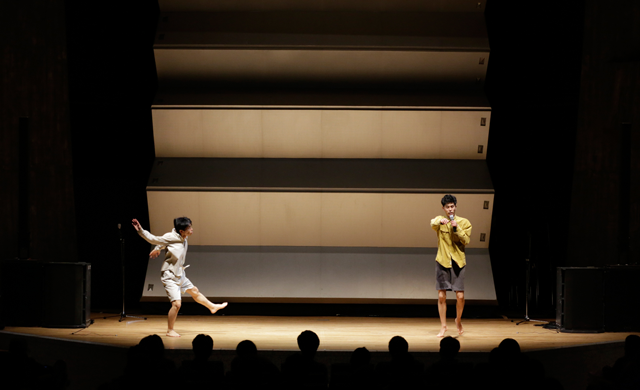
Photo: Hideto Maezawa

↓↓↓Scroll down for English↓↓↓
『ヘッドホンと耳の間の距離』
せっかくのライブ、まわりの観客がゴソゴソ、微かな空調、場所によっては外から漏れ聞こえる車の音や足音、それが良かった、例えば上演中に天井のギシギシする音が良かった、とか言うのはとりわけダンスや演劇などでは臨場感を楽しんだ、というよりも単にマニアックな人の感想として取り扱われる。
ダイレクトに耳に届けるはずのヘッドホンを両手で少し離して街の喧騒を歩く。じつは今まで聞こえていたけど聞こえてないと見なしていたものが、耳とスピーカーの間で存在感を増す。
観客席をスピーカーが包囲する。聞こえてはならないものが上下左右から降り注ぐ。舞台上での出来事とジャストフィットするならまだましな効果だったとしても、遅れていたり、早かったり、タイミングの合わなさを2人の出演者とともにオペレートする。
演出・振付:山下残|出演:川名俊生、木下毅人|音響設計:福田拓人|助成:公益財団法人セゾン文化財団|初演:STスポット(2012年10月10日)
振付家・演出家。1970年大阪府生まれ。作品に、日本語と英語での日記の朗読とそれに基づく振付を哲学的ヒップホップともいうべき次元に到達させる『横浜滞在』(2002~)、尾崎放哉の自由律俳句の身体による読解とジャズ・スタンダードが意表を突く形で遭遇する『せきをしてもひとり』(2004~)、客席の頭上に流される水面の映像とフィールド・レコーディングによる音が自然的・政治的カタストロフを予感させた『大洪水』(2010)、4トンの瓦礫を高松で拾い舞台装置を作った『大行進』(2010)、廃材と言葉と身振りをコンピューター・プログラミングによって構築した『庭みたいなもの』(2011~2012)など。
The Distance between Headphones and Ears
Rustle from some audience members, faint noise from the air conditioner, or in some kind of venues the sounds of cars and footsteps from the outside: appreciating these things, for example saying “It was nice to hear the creaking sounds of the ceiling during the performance,” is usually considered to be perverse, rather than expression of enjoyment in a live performance, especially in dance and theatre.
Slightly detach your headphones, which are supposed to deliver sound directly into the ears, with both hands and walk in the crowded street. Things that you had actually heard but ignored gain presence between the ears and the transducers.
Loudspeakers surround the audience. Things that are supposed to be inaudible pour on them from all the directions. Probably it is not too bad if the sounds perfectly synchronize with what is going on on the stage, but we articulate them in their haste, latency and out-of-syncness with the two performers.
Directed and choreographed by Zan Yamashita | Performers: Toshiki Kawana and Takehito Kinoshita | Sonic design: Takuto Fukuda | Supported by The Saison Foundation | Premiere: ST Spot (October 10, 2012)
Choreographer and performance maker. Born in Osaka in 1970. Among his works are Yokohama Stay (2002–) that brings a reading of his diary and choreography based on it to the dimension of what can be called philosophical hip-hop, It’s just me, coughing (2004–) in which interpretation of Hosai Ozaki’s free-form haikus through the body and jazz standards encounter in an unpredictable way, Daikozui (2010) that involved overhead screening of the image of the surface of water and field recording indicating natural and political catastrophe, Daikoshin (2010) for which four tons of rubble and waste materials were collected in Takamatsu to construct the stage, and It is something like a garden (2011–2012) that employed computer programming to structure waste materials, words and gestures.
